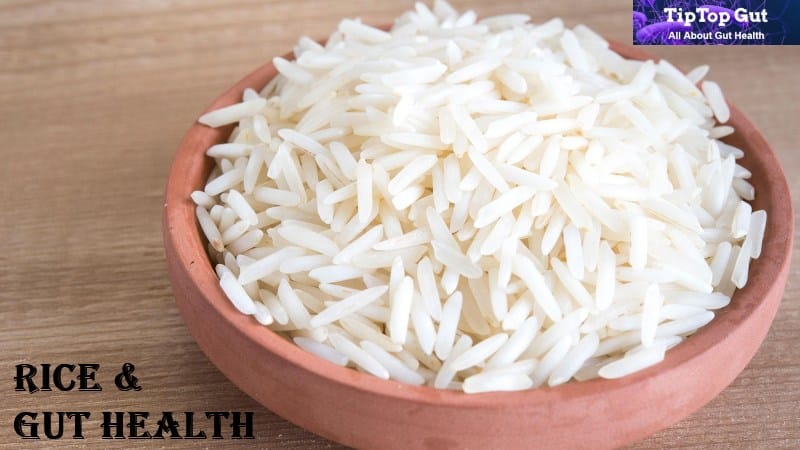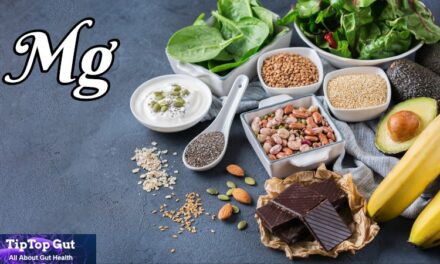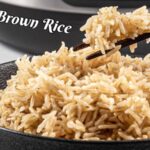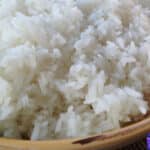Some individuals eat rice for breakfast, lunch, and dinner because it is a widespread staple worldwide. Rice is a nutrient-rich food that is readily available and useful for treating a number of gastrointestinal problems, such as constipation and diarrhea.
Unrefined or refined rice are the two options available, and each has a unique set of possible advantages for treating gastrointestinal issues. Here, you’re going to read, ‘is rice good for gut health?’
Cereal grass produces rice, Oryza sativa, as its seed. With more than half of the world’s population reliant on it, it ranks among the most significant dietary carbs. In addition to being boiled or steamed, rice can be crushed into gluten-free flour. It plays a significant role in many cuisines, including India, China, and Southeast Asia.
Although there are several rice varieties can be broadly divided into two groups based on their form (long or short grain) and color (white or brown). Both the nutrient-rich germ and the fiber-rich outer bran of white rice have been removed from the grain.
It has a longer shelf life, as a result, cooks quickly, and has a bland, neutral flavor. However, it is less nutritious than whole-grain alternatives in fiber and protein. Contrarily, brown rice has both bran and germ, making it rich in nutrients and fiber while retaining a nutty flavor.
Is Rice Good For Your Gut Health?
When rice grains cool, their starch transforms into “resistant starch.” They are prebiotics as a result (food for the microbes in your gut). The fermentation of rice results in the formation of gut-friendly bacteria, and adding rice further increases the number of bacterial strains.
Carbohydrates, the body’s primary fuel source, are abundant in rice. You can stay energized and satiated with carbohydrates, essential for fueling physical activity. Mainly brown rice is an excellent source of fiber, manganese, B vitamins, selenium, and magnesium.
Brown Rice vs. White Rice
Healthy gut bacteria are encouraged to thrive and function by the nutrients in brown rice. Although white rice has been treated to remove the outer layers to have a longer shelf life and require less cooking time, brown rice and white rice are essentially the same. White rice has less fiber than brown rice because it no longer possesses the outer layer.
But as a result, white rice is frequently supplemented with vitamins and minerals that may otherwise be lost during milling. This is only one advantage of white rice. Let’s look at why this qualified nutritionist recommends white rice.
The ease of digestion of white rice is well recognized. It is accessible on the stomach because it is low in fat and fiber. Because white rice is not connected to any digestive problems, many individuals like it over brown rice. In reality, because it is a simple source of carbs for instant energy, white rice is regarded as a “safe starch” for athletes.
Eat white rice alone or with other low-fat dishes to simplify the digestion of the grain. Vegetable oils are one example of fatty food that takes longer to digest and may be uncomfortable.
Read More:
Biotics 8 Review: SCAM or A Legit Probiotic for Men?
Reasons – How is rice good for your gut health?
Rice is good for gut health; let’s discover the reasons how?
It’s gluten-free
White rice is the best option if you need to add more substance to a soup, stew, or casserole while adhering to a gluten-free diet. There are several gluten-free pasta alternatives available; however, white rice is probably the least expensive.
White rice gives you energy
White rice is a carbohydrate food that gives us brisk energy. White rice can be processed more quickly than brown rice, giving us both the energy and comfort of eating rice with our meals.
It has B vitamins, Iron, and magnesium
Most people enjoy eating rice every day because of its energy-giving effects, which are directly tied to white rice’s iron and B vitamins. Another benefit of white rice at dinnertime is that its magnesium has been related to restful sleep.
White rice is simple to assimilate
The white rice is gentle on the stomach. Foods that take longer to digest include meat and leafy greens. Since white rice doesn’t, it’s an excellent option for evenings when dinner is late or when you’re just recovering from a cold and reintroducing food to your diet.
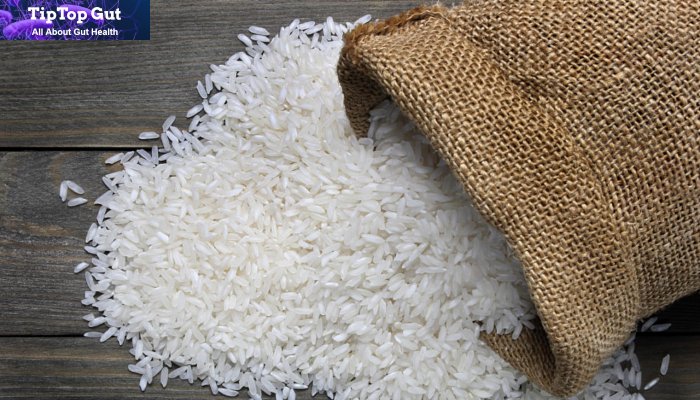
Different Forms of Rice – Helpful for Your Digestive System
Following are some of the rice forms that are helpful for your digestive system.
Whole-Grain Rice Benefits
The insoluble fiber in whole-grain rice may aid with symptoms of irritable bowel syndrome, inflammatory bowel disease, and other conditions. For instance, insoluble fiber stimulates feces to pass through your colon more quickly, which relieves constipation.
However, the more significant insoluble fiber level can also increase gas and bloating, which can be uncomfortable, especially for those with IBS or inflammatory bowel disease.
Refined Rice Benefits
Because the bran, which contains most of the insoluble fiber, has been removed during processing, refined rice has a low fiber content. Diarrhea, a sign of irritable bowel syndrome, inflammatory bowel disease, and other conditions, can be relieved by eating white rice.
Rice for Bowel Problems
Constipation, diarrhea, stomachaches, gas, and bloating are common symptoms of bowel diseases, such as irritable bowel syndrome and inflammatory bowel disease. A diet high in fiber, such as one that regularly includes rice consumption, can help ease, lessen, or even prevent the symptoms, even though the underlying causes can vary.
Is Rice a Probiotic?
Living bacteria found in fermented foods are referred to as probiotics. Contrarily, probiotics feed the healthy bacteria in the gut, increasing their population—this aids in enhancing digestion and gut bacteria. Probiotics are beneficial to those who experience digestive problems.
Probiotics also aid in weight loss and boost immunity, among other health benefits. White rice and water are popular, delicious, and simple probiotic dishes.
Studies are being conducted all over the world since it is believed that fermented rice contains significant amounts of probiotics. Live bacteria, known as probiotics, are ingested through fermented foods or supplements.
It encourages a favorable environment for the gut flora, which has been associated with numerous additional health advantages.
Is Rice a Prebiotic?
Foods called “probiotics” are those that feed your beneficial bacterial strains called “Probiotics”. Probiotics are abundant in the resistant starch that results from overnight rice fermentation. Even after being heated up, cooked rice retains its prebiotics. Also included is RS3 starch. Enjoy the prebiotic advantages of cooked and cooled white rice!
Starchy foods are frequently linked to diabetes and weight gain. It’s crucial to realize that resistant starches are the ones that withstand digestion and travel directly to the colon, where they feed the healthy bacteria in the stomach.
Both beneficial and harmful bacteria can be found in the gut. Numerous health issues manifest when the harmful bacteria overpower the beneficial bacteria. Many harmful gut bacteria can cause autoimmune diseases, leaky gut, bloating, indigestion, and even sugar cravings.
Read More:
60 Best Foods for Gut Health and Digestion: The Best Guide You Ever Need!
Easiest Probiotic Dish with Only Two Ingredients!
All you need to make this easy, 2-ingredient probiotic is cooked white rice and water. Keep cooked white rice and some water in a clay pot. Overnight, leave the clay pot covered. The following morning, the probiotic is prepared for consumption. For optimum gut health, take this probiotic first thing in the morning.
White rice contains resistant starch, which travels to the colon and feeds beneficial bacteria, boosting their number there. Butyric acid, a product of this reaction, has anti-inflammatory properties. While taking this probiotic can aid your gut health, it’s important to remember that a nutritious diet and regular exercise will enable you to maintain good overall health.
Other Health Benefits of Rice
Following are some of the proven health benefits of rice.
Promotes Healthy Nervous System
Utilizing several B vitamins is necessary to operate our nervous systems efficiently. A variety of B vitamin subtypes aids neurotransmitter production. The neurotransmitters help to regulate biological processes.
Rice is an excellent source of many B vitamins. Because rice has a lot of B vitamins, eating it can help to boost the health of your neurological system.
Digestive and diuretic properties: Stops constipation
Have you recently had intestinal problems? You can easily control your digestive system by eating rice. Those who suffer from high blood pressure and other illnesses will benefit from this. By removing water from the body, you urinate more frequently, which helps the body get rid of uric acid and may even aid in weight loss! Your kidneys profit in return as a result.
Remember to drink enough water because your body will lose more water.
Suitable Protein Source
Are you a committed gym goer? Have you adopted a vegan diet? If so, rice is a fantastic source of the necessary protein!
If you exercise frequently or follow a vegan or vegetarian diet, eating high-protein rice, whether white or brown, is an excellent method to keep your protein levels where they need to be. This dry brown rice contains 6 grams of protein every 1/4 cup. Additionally, 1/4 cup of this dried white rice contains 5 grams protein.
It can occasionally be challenging to find foods that are strong in protein while being regarded as vegan or vegetarian. Eating rice is a great method to augment other high-protein vegan or vegetarian foods.
Promotes Heart Health
Have you been looking for suggestions for natural ways to enhance the health of your heart? If so, frequent rice consumption might be the solution you’ve been seeking for!
The anti-inflammatory properties of rice contribute to a reduction in the rate at which atherosclerotic plaque deposits within blood vessel walls. Your risk of developing severe heart diseases like heart attacks or strokes is reduced.
Even though both white and brown rice has these advantages, brown rice is more advantageous. This is a result of the husk of brown rice, which is where most of the nutrients are located. Another excellent source for enhancing heart health is rice bran oil.
Antioxidant qualities found in rice bran oil help lower cholesterol levels in the body and eventually improve cardiovascular health.
Read More:
Best Probiotic for Gut Health and Bloating: According to Health Experts
Can Aid in Lowering Cancer Risks
Are you trying to prevent cancer risks by being proactive? Rice and other high-fiber foods can lower your risk of developing cancer!
The high fiber content of rice helps with digestion and lowers blood pressure. In exchange, your body as a whole is healthier. A healthy digestive system also prevents the body’s waste from amassing for extended periods.
The likelihood of this waste connecting with healthy cells in the body is decreased by maintaining the flow. This is beneficial in the fight against and prevention of colorectal and intestinal cancer. However, rice’s fight against cancer is far from over.
Avoids Obesity
Have you been trying to lose weight but are still determining the foods that will make the process easier? Try a healthy serving of rice instead! Because rice contains no sodium, fat, or cholesterol, it helps to fight obesity. It is nutrient-dense and does not significantly harm a person’s health. Of course, its high fiber content also contributes to decreased obesity.
Suitable for Skin Care
Are you looking for a natural skin care product but unsure where to start? You might be surprised to hear that rice is an excellent skincare item!
Both topically applied rice and rice consumption are used for skin treatment. You can use rice in its powdered form as a topical remedy by rubbing it on the skin. Inflamed skin responds well to this topical treatment since the powder will aid in lessening swelling.
Read More:
Is Cheese Good for Gut Health? Shocking Facts Unfolded 2022
Easy Ways to Make Rice Healthier and More Gut Friendly
Following are some simple tips and tricks to make rice more gut friendly.
Reduce Arsenic and Ease Digestion by Soaking Rice
According to studies, soaking the rice for just one night can reduce its arsenic content by up to 80%. Additionally, grains that have been soaked before eating are less likely to contain lectins, which are found in some forms of brown rice, and phytic acid, a potent inhibitor of mineral absorption in the stomach. Before cooking the rice, thoroughly rinse it. Arsenic levels are drastically reduced as a result.
Rice is prepared with bone broth and coconut oil
It’s pretty simple to increase the nutritional value of bone broth in your diet by cooking the rice in homemade bone broth. If you don’t have any homemade broth on hand, add a large tablespoon of any Gevity Bone Broth Concentrates. Just use purified water for cooking the rice if you’re vegan or vegetarian.
When cooking rice, use healthy fats like coconut oil. When these are cooked together, the oil bonds the rice’s digestible starch (the starch that converts to glucose). The resistant starch is created when the digestible starch crystallizes after being coupled with the coconut oil.
Allow Rice to Cool To Produce Resistant Starch
Additionally, coconut oil helps to crystallize the rice by cooling it for 12 to 24 hours. According to one study, this raised RS by 10–15 times while lowering calories by up to 50–60%. Because there is more resistant starch to replace digestible starch, the rice results in a lesser blood sugar surge. Additionally, the resistant starch’s inherent properties further reduce this modest surge. Lower-carb rice is the end outcome.
Concluding Now! Is Rice Good for Gut Health?
Rice has several advantages when consumed frequently. High-protein rice is the perfect option if you’re looking for a protein-rich cuisine for your vegan or vegetarian diet or an outstanding pre-workout meal! There are numerous ways both brown and white rice can enhance the general health of your body.
The resistant starch in rice turns into prebiotics, which is beneficial for the microorganisms in your gut. When rice grains cool, the starch is changed to “resistant starch.” They are, therefore prebiotics (food for the microbes in your gut). The fermentation of rice results in the development of gut-friendly bacteria, and adding rice increases the amount of these bacteria by a few additional strains.
FAQs about Rice and Gut Health
How rice benefits digestive gut health?
Rice is a nutrient-rich food that is widely accessible and can help with a number of gastrointestinal issues, including constipation and diarrhea. There are two varieties of rice available: refined and unrefined, and each has a unique set of potential advantages for treating gastrointestinal issues.
With one significant exception, white rice is identical to brown rice except that the bran and germ have been removed. Because of this, white rice becomes more sensitive and delicate and cooks more quickly. Red, brown, and black are just a few colors available for brown rice, sometimes referred to as whole-grain or unprocessed rice.
Is white rice beneficial to intestinal health?
White rice is a wonderful choice for persons with digestive issues, nausea, or heartburn because it is bland, low in fiber, and simple to digest. When you consume refined white rice, you consume a significant amount of soluble fiber or butyrate.
By lowering inflammation, butyrate can improve the health of your gut. For this reason, eating boiling rice is frequently suggested when someone has diarrhea.
What Is the difference between Refined vs. Unrefined Rice?
With one significant exception, refined rice, often known as white rice, is identical to brown rice but for the removal of the bran and germ. Because of this, white rice becomes more sensitive and delicate and cooks more quickly.
Red, brown, and black are just a few colors available for brown rice, sometimes referred to as whole-grain or unprocessed rice. In addition to having a chewier texture and nuttier flavor, whole-grain rice has more dietary fiber and essential minerals like protein.
Which is better for intestinal health, white rice or brown rice?
As compared to white rice, brown rice is more nutrient-dense. As a result, brown rice may lower blood sugar levels and support efforts to lose weight. White rice, however, is beneficial for people with digestive issues who have trouble properly digesting fiber-rich diets.
Is eating whole-grain rice good for your health?
The fiber-rich whole grains will aid in colon cleansing. Eating whole-grained rice can alleviate some symptoms of irritable bowel syndrome, inflammatory bowel disease, and other conditions.
Does rice help with leaky gut?
Focus on eating things that encourage the growth of good bacteria when you have a leaky gut issue. It’s crucial to know the correct kinds of grains to eat to benefit rather than harm your digestive health because grains, in particular, can be hit or miss. Gluten-free grains, including rice (white or brown), gluten-free oats, and buckwheat are good grains.
Read More:
Best Probiotic for Gut Health and Weight Loss: An Ultimate Guide
Best Time to Eat Sauerkraut for Gut Health: All You Need to Know in 2022
Can Tomatoes Cause Bowel Problems? 4 Shocking Facts Unveiled
Are Tomatoes Bad for Your Gut Health? Hidden Truth Unveiled!
Is Honey Good for Gut Health: Amazing Truth Revealed
Do Tomatoes Cause Leaky Gut? Know the Truth
Sources and References
At TipTop Gut, we rely on peer-reviewed studies, academic research institutions, and medical associations. We avoid using tertiary references.
- Jean Hailes
- LiveStrong
- EatThis
-
McKeown NM, Troy LM, Jacques PF, Hoffmann U, O’Donnell CJ, Fox CS. Whole- and refined-grain intakes are differentially associated with abdominal visceral and subcutaneous adiposity in healthy adults: the Framingham Heart Study. Am J Clin Nutr. 2010 Nov;92(5):1165-71. doi: 10.3945/ajcn.2009.29106. Epub 2010 Sep 29. PMID: 20881074; PMCID: PMC2954448.
-
Mohan V, Spiegelman D, Sudha V, Gayathri R, Hong B, Praseena K, Anjana RM, Wedick NM, Arumugam K, Malik V, Ramachandran S, Bai MR, Henry JK, Hu FB, Willett W, Krishnaswamy K. Effect of brown rice, white rice, and brown rice with legumes on blood glucose and insulin responses in overweight Asian Indians: a randomized controlled trial. Diabetes Technol Ther. 2014 May;16(5):317-25. doi: 10.1089/dia.2013.0259. Epub 2014 Jan 21. PMID: 24447043; PMCID: PMC3996977.
- WebMD
-
Kolahdouzan M, Khosravi-Boroujeni H, Nikkar B, Zakizadeh E, Abedi B, Ghazavi N, Ayoobi N, Vatankhah M. The association between dietary intake of white rice and central obesity in obese adults. ARYA Atheroscler. 2013 Mar;9(2):140-4. PMID: 23690814; PMCID: PMC3653247.
-
Ravichanthiran K, Ma ZF, Zhang H, Cao Y, Wang CW, Muhammad S, Aglago EK, Zhang Y, Jin Y, Pan B. Phytochemical Profile of Brown Rice and Its Nutrigenomic Implications. Antioxidants (Basel). 2018 May 23;7(6):71. doi: 10.3390/antiox7060071. PMID: 29789516; PMCID: PMC6025443.
-
Liu K, Zheng J, Chen F. Effects of washing, soaking and domestic cooking on cadmium, arsenic and lead bioaccessibilities in rice. J Sci Food Agric. 2018 Aug;98(10):3829-3835. doi: 10.1002/jsfa.8897. Epub 2018 Mar 12. PMID: 29363749.
- Colorado State University

